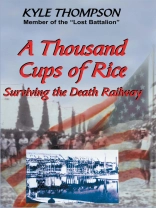You are only a few remaining skeletons after the invasion of East Asia for the past few centuries and are pitiful victims. We will build the railroad if we have to {build} it over the white man’s body. If you want anything, you will have to come through me. . . . and there will be many of you who will not see your homes again. Work cheerfully at my command.
-Lt. Col. Y. Nagatomo, Chief, No. 3 Branch, Thailand POW Administration, Nippon Expeditionary Force
With these words, thousands of Allied prisoners were sentenced to their deaths on the ‘Burma-Siam Death Railway.’ Among the victims were Texans of the 2nd Battalion 131st Field Artillery, and survivors of the sunken USS Houston.
In 1939, while the Great Depression still loomed over the country, Kyle Thompson enlisted in the Texas National Guard at Wichita Falls, Texas. Thompson was only sixteen years old, and his mother had signed papers listing his age as eighteen so that he could join the military and draw the few dollars paid monthly to guardsmen.
After Nazi Germany overran most of Europe, President Franklin D. Roosevelt convinced Congress in 1940 to mobilize U.S. forces. Along with thirty thousand other members of the 36th Division, Thompson’s unit was inducted into the regular army and sent to Camp Bowie in Brownwood, Texas, for intensive training.
Thompson was a member of the 2nd Battalion, 131st field artillery. The 2nd Battalion was deployed to the Netherland East Indies on January 11, 1942, the same day Japanese forces began their invasion of the island. After three months of intense fighting, the 2nd Battalion surrendered to the Japanese. It became known as the ‘Lost Battalion’ due to its location being unknown throughout the remainder of World War II.
Moved to various prisoner of war camps throughout Southeast Asia, the ‘Lost Battalion’ endured severe brutality, starvation, and disease. In 1943 they were moved to Burma, where they worked on what became known as the Japanese ‘Railroad of Death, ‘ which led to the death of 70, 000 Allied prisoners and was the basis for the movie, The Bridge Over the River Kwai. In A Thousand Cups of Rice, Thompson recounts how he and the other prisoners survived their inhumane treatment and years of hard labor with little food and scarce medical treatment. All told, Thompson spent six years in the U.S. Army, four of them overseas in the southeast Asian theater of war.
Yazar hakkında
Following his military service, Thompson became a journalist whose long career carried him into politics at both the state and national levels. In 1949, after returning to civilian life, he earned a Bachelor of Arts degree from Midwestern State University in Wichita Falls. Following a stint as a reporter for the Wichita Falls Record News, he joined United Press International in their Dallas office. He was later named manager of the Houston UPI office. In 1962, he moved to Austin to become bureau manager and chief UPI political writer in Texas. The following year, he was named press secretary to Governor John B. Connally and later became press secretary to U.S. Senator John G. Tower in Washington. He returned to Texas to take charge of the Fort Worth Star-Telegram editorial page until his retirement in 1987. The Thompsons then made their home in Austin, where he served as secretary of the Lost Battalion Association and was active in several statewide political campaigns. Kyle Thompson passed away in 2004 and is buried in the Texas State Cemetery.












